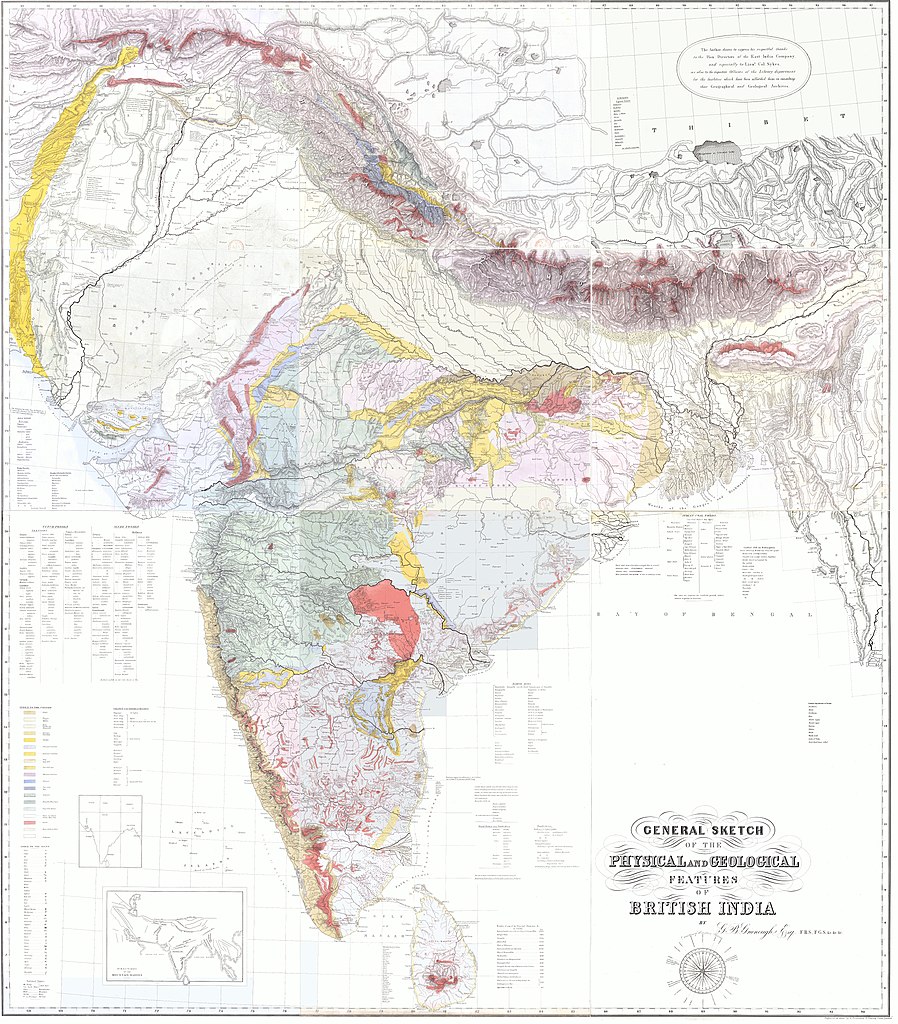Crowd might be a bit of a stretch for less than a hundred contributors but George Bellas Greenough (1778 – 1855), one of the founders of the Geological Society of London produced the first geological map of India which was posthumously published in 1855. Greenough was the first president of the Geological Society of London and was reportedly best known for his ability to compile and synthesize the works of others and his annual addresses to the Society were apparently much appreciated. He was however entirely against the idea that fossils could be used to differentiate strata and in that he failed to admire William "Strata" Smith who produced the first geological map of England. One obituarist noted that Greenough was an outspoken critic of theoretical frameworks and a "drag" on the progress of the science of geology!
Not much has been written about the history of the making of the Greenough map of Indian geology - it was begun somewhere in 1853 and was finally published in 1855, consisted of four sheets and measured 7 by 5¾ foot. A small number of copies were made which are apparently collectors items but hardly any are available online for anyone wishing to study the contents. The University of Minnesota has a set of scanned copies of three-fourths of the map but if you want to read it you need to download three large files (each of about 300 MB!) . I decided to stitch together these images and to enhance them a bit and since the image is legally in the public domain (ie. copyright expired), I have placed it on Wikimedia Commons. There really is a research need for examining the motivations for making this map and on how Greenough went about to produce it. He apparently had officers of the East India Company providing him information and he seems to have sent draft maps on which they commented. There is a very interesting compilation of the correspondence that went into the making of this map. It has numerous errors both in geology as well as in the positions and labelling but is definitely something to admire for its period. Thomas Oldham representing the professional GSI in India was particularly critical while heading a committee (that included Henry "Cyclone" Piddington) to examine the map.
One has to lament that nobody has made a more up-to-data geological guide to interesting formations, fossil localities and so on.
Here is a small overview of the 1855 map. You can find and download the whole image on Wikimedia Commons.
You can zoom into this image and enjoy the details by using this viewer that uses the Flash plugin or this one that is Flash-free.
An even higher resolution stitch can be found here (with the zoom-viewer here)
PS: November 8, 2016 - just created an entry in Wikipedia for Henry Wesley Voysey (with the only known portrait of the man when no likeness has been recorded by the Oxford Dictionary of National Biography!) who is wrongly claimed by D T Moore to have made the first geology map of India - covering a part of the Hyderabad region (1821) but the two known copies of that map disappeared from Calcutta and London. An older geology map is by Benjamin Heyne published in 1814.
😃April 11, 2018 - thanks to David G. Bate, there is now a complete map in the French digital library. The above image is now complete.
PS 6-May-2022: Some years ago I had collected examples of crowd-sourcing in science from India, and had misplaced them. So here is another example where the Asiatic Society of Bengal was trying to study barometric pressure trends across the country by distributing "philosophical instruments" to collaborators across India. From Journal of the Asiatic Society of Bengal. Volume 5. 1836.


Some one in pinterest has it. https://www.pinterest.com/pin/455285843552691012/
ReplyDeletehttps://www.google.co.in/imgres?imgurl=https%3A%2F%2Fs-media-cache-ak0.pinimg.com%2F564x%2F6b%2F04%2Fd0%2F6b04d07a663339605dcea6493ff4774c.jpg&imgrefurl=https%3A%2F%2Fwww.pinterest.com%2Fpin%2F455285843552691012%2F&docid=X_2j_XWpFdidcM&tbnid=aI8nGID6Ez7dUM%3A&w=414&h=483&bih=662&biw=1366&ved=0ahUKEwjanf-50qLPAhUN-GMKHbRVD_MQMwgmKAEwAQ&iact=mrc&uact=8
Thanks Sowmyan. I have seen this, it is a very low resolution image of a map auctioned by Sotheran's. Nothing legible in it, sadly.
DeleteFor anyone interested in Greenough's India map I have recently published a lengthy article on this in Earth Science History, Vol.41, pp.285-321 for 2022 ('George Bellas Greenough's General Sketch of the Physical and Geological Features of British India (1854, 1855): Its Production, Distribution, Variants and Survivorship').
ReplyDelete